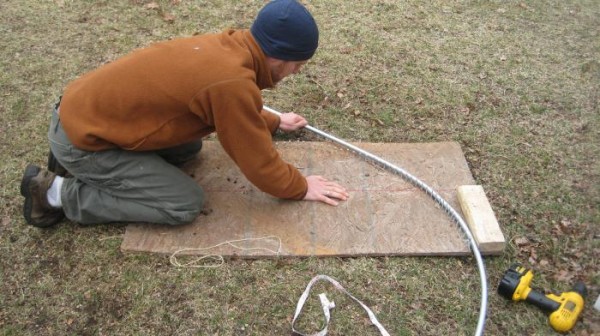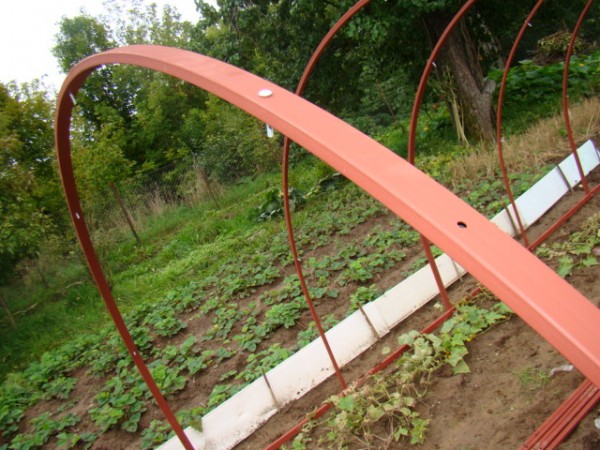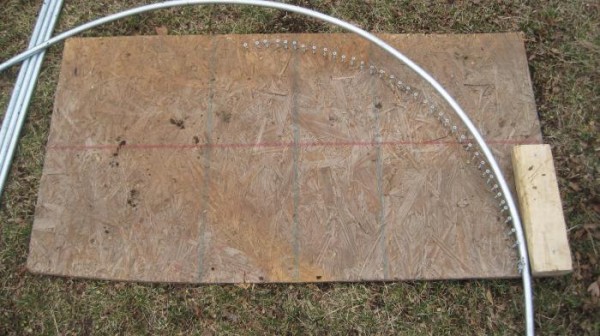What are the arcs for a greenhouse and how to do it yourself
Content
What are
For such a structural element, the material used is very important. Greenhouse arches should be lightweight, strong and durable. A greenhouse is erected on the site every year, so they need to serve for more than one decade. Moreover, they must have an acceptable cost. The optimal material for them is metal, wood or plastic.
- Metal arches for a greenhouse are used by every third owner of a suburban area. Various metal elements are used for their manufacture: pipes, fittings, thick wire, etc.
- Plastic constructions are no less popular. They are lightweight, durable and resistant to the negative effects of various environmental factors.
- Structures made of PVC profile do not differ from plastic ones in terms of properties, quality and cost. Arcs for greenhouses, which are planned to be sheathed with polycarbonate, are convenient from this material.
- Wood structures are used less often, although they are environmentally friendly, strong and durable.
Fiberglass structures are characterized by lightness, strength and reliability.
How to do it yourself
Arcs are the element in the greenhouse that you can make yourself. The main thing is to choose the right material for their manufacture. It should bend easily and work well. Structures made from it, despite their length, should be lightweight, but strong and reliable. The easiest way to make arcs for a greenhouse with your own hands is from plastic pipes intended for arranging a water supply system. Moreover, even defective ones are suitable. They have a low cost, so you can experiment with this material to your heart's content.
In the simplest version, along the greenhouse every half a meter, pins protruding 15-20 cm are driven into the ground on both sides. The ends of pipes bent by an arc are put on them, the length of which is determined by the height of the structure. Another pipe should be fixed from above along the greenhouse to connect the frame into a single whole.
A more durable and reliable design is obtained by using metal rods, the thickness of which allows them to freely enter the pipes. They are cut into 60 cm pieces and driven into the ground to a depth of 20 cm in those places along the greenhouse where the ends of the curved profiles should be located.
Then, using a wire gauge, their size is selected. After that, the wire is applied to the pipes and they are cut to the desired size. To make arcs from a PVC profile, you will need a building hair dryer and a number of special connecting corners and crosses for the convenience of connecting individual strips. Work should begin with making a wire template. Also, the required bend can simply be drawn on a flat surface. Then the profile is warmed up by a hairdryer heated to 180 ˚C and gently bent according to the template.
The number of arcs is made on the basis of their placement every half a meter along the greenhouse. At the same time, they should be mounted perpendicularly along the entire length of the rib, placing one on top and two on the sides. If the greenhouse is made high, then the number of side ribs increases. Despite the fact that the PVC profile bends quite easily without heating, it is not recommended to make the frame in this way, especially if polycarbonate will be used for cladding in the future. With such a deformation, a constant internal stress occurs in the material, and when using self-tapping screws, the profile can simply burst.
In the event that a hairdryer is unavailable for one reason or another, you can do without it, but in this case, the polycarbonate will have to be fixed with clamps according to the following scheme: from the inside, a metal or plastic clamp is applied to the profile girth and the polycarbonate sheet is attracted to the profile by two self-tapping screws with thermal washer. In this case, the profile is not damaged, however, another difficulty arises - you will need to make many holes in the polycarbonate itself, which does not like it very much. Making a structure out of wood is somewhat more difficult. For these, use good quality, knot-free planks up to 12 mm thick. Moreover, it is better to take freshly sawn wood. Dry planks will need to be soaked in water for a day to increase their elasticity.
Before proceeding directly to the arcs, you will need to calculate and make a special template. To do this, an even board from an edged board is knocked down, on which the arc being made must fit completely. In the middle of such a shield, a bar is fixed, the thickness of which is not less than the width of the future arcs, and the length is equal to the height of their bending with the addition of 10 cm. This addition is made taking into account some straightening after assembly. The bar should be located in the middle of the height of the curved wooden plank. In three places - at the ends and at the upper bend point, the bar is clamped between two parallel small bars. If the arc is larger than three meters, you can add two additional bars to make it smooth.
After that, a bending bar is laid on the shield according to the template. Another one is placed under it and they are pulled together with self-tapping screws with a step of 25 cm. Then a third plank is placed under them and they are all pressed again with self-tapping screws, only of a larger size. Further, after tightening, the first arc is removed and tried on to the greenhouse structure in order to adjust the template made on the shield. If necessary, adjustments are made to it and then the required number of arcs are made.
When making metal arcs, you should choose easily deformable elements. It is quite problematic to bend a metal corner or a profile pipe with your own hands without a special machine. But the fittings can be given the required shape without much difficulty. Moreover, the resulting structure will be characterized by strength and will withstand significant loads. If you slightly increase the financial costs, time and effort, you can create an ultra-reliable and durable greenhouse by packing steel reinforcement in plastic pipes. Such a pipe will protect the film used as a coating from abrasion at the points of contact with the curved profile and will protect the reinforcement from premature wear and the negative influence of natural factors.
Video "How to make a greenhouse with your own hands"
Video instruction.
Advantages and disadvantages
Metal steel arcs are reliable and durable. They allow you to mount large greenhouses and are quite complex in design. They are easy to install and dismantle. Such frames are capable of withstanding significant loads, therefore even large greenhouses are resistant to strong gusts of wind and are suitable for any type of covering material.But at the same time, they are quite heavy in weight and have a high cost.
Plastic bows are a great budget option. They are lightweight, easy to install, suitable for year-round use and do not require painting. They are not afraid of high humidity, frost and temperature drops. Arcs made of PVC profile are excellent for covering with polycarbonate. The main thing when choosing such arcs is the high quality of the material, which guarantees excellent performance and durability. Greenhouse arcs made of wood are characterized by high reliability and environmental friendliness. But to ensure durability, the tree must be pre-properly treated with a special antiseptic, and the structure itself must be made with high quality.
Video "How to make metal arches for a greenhouse"
One of the options for creating arches for greenhouses.






